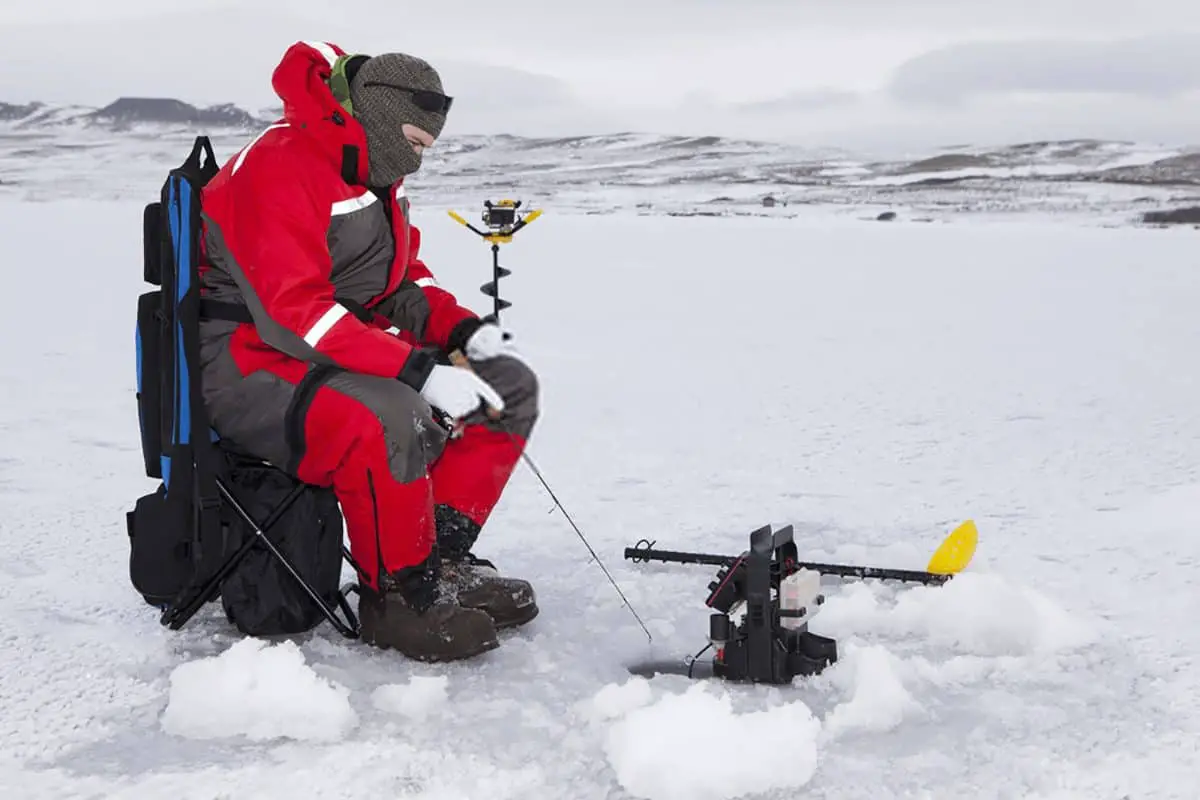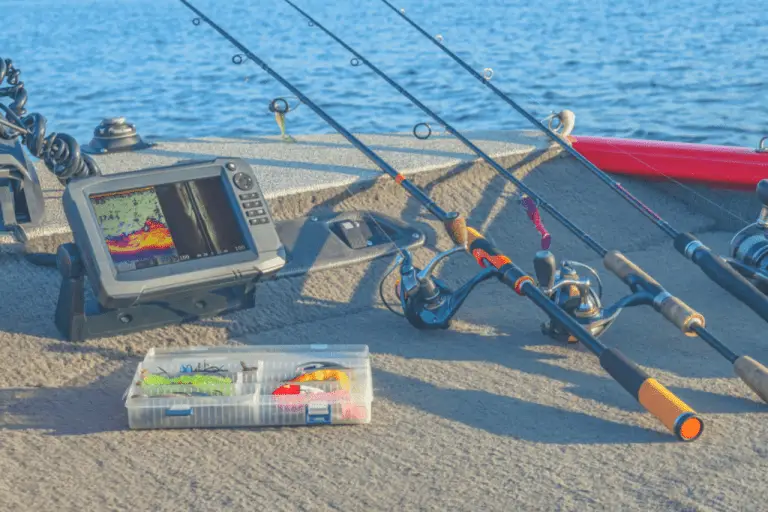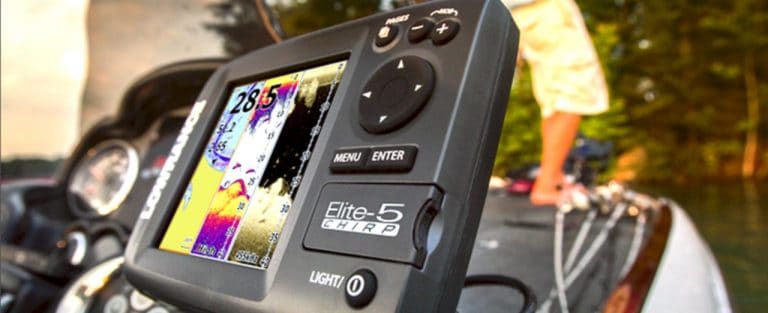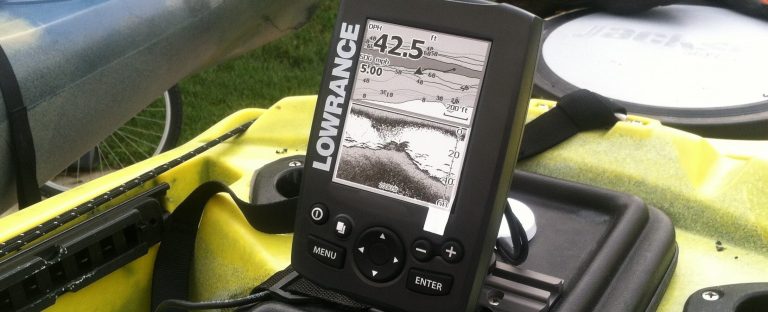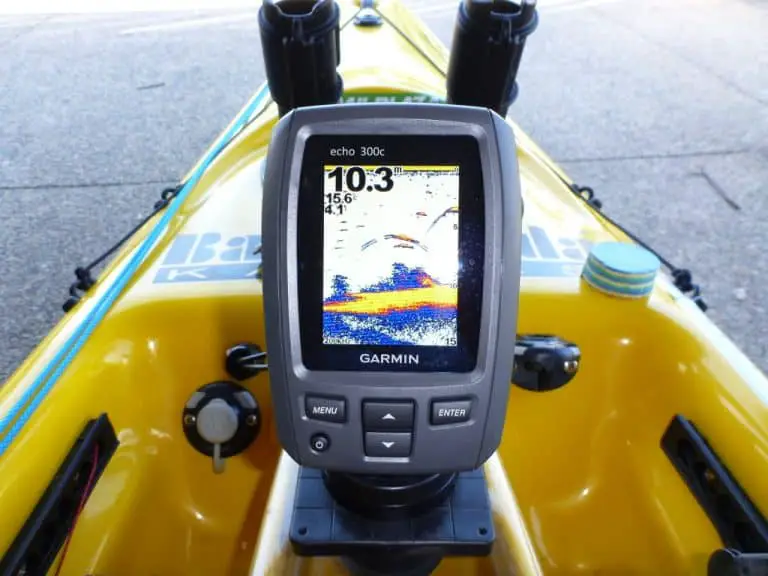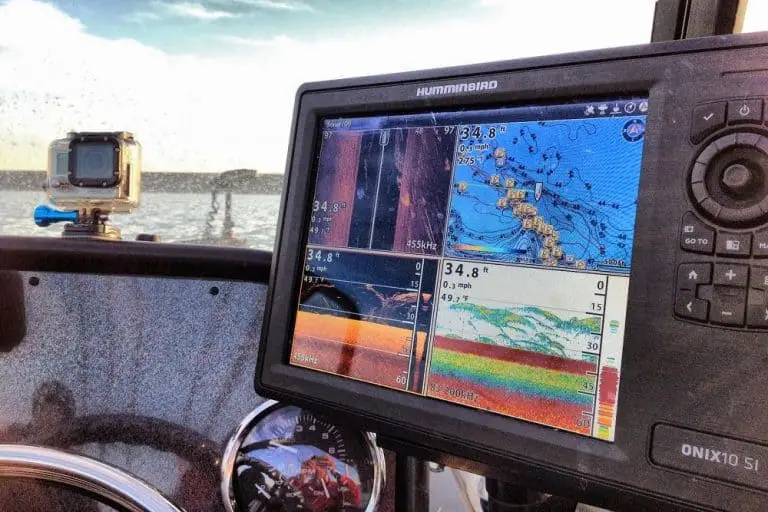Best Ice Fishing Fish Finders That Work Like Magic in 2023
Moving around and digging experimental holes until you reach your heavenly spot is the worst part about this thrilling winter sport. Icefish finders save your time and effort by exposing what’s beneath the ice without a hassle.
Many companies produce ice fish finders in the form of specialized devices or simple add-ons in regular devices. With many features and technical aspects, you might get confused regarding which is best for what.
It’s cold! So buckle up and read on to discover the best ice fishing fish finders currently available. We’re going to show you a variety of models that match various skill levels and budgets to help you narrow down your choices and find your new best ice friend.
Table of Contents
At a Glance:
- Garmin Striker 4 with Portable Kit – Our Top Choice
- Marcum LX-7 Ice Fishing Sonar – Advanced Digital Technology
- HawkEye Fishtrax 1C Fish Finder – Best Real-time Sonar
- Deeper PRO+ Smart Sonar – Best Castable Fish Finder
- Venterior VT-FF001 Portable Fish Finder – Budget Choice
Comparison Table:
| Fish Finder | Dimensions | Weight | Depth | Frequency | Price |
|---|---|---|---|---|---|
| Garmin Striker 4 with Portable Kit | 3.6 x 1.6 x 5.9-in. | 10.8 lbs. | 1600 feet | 77-200 kHz | CHECK PRICE |
| Marcum LX-7 | 11.5 × 11.5 × 11.5-in. | 11 lbs. | 300 feet | 50-200 kHz | CHECK PRICE |
| HawkEye Fishtrax 1C | 6 x 3 x 2-in. | 0.64 lbs. | 240 feet | 83-200 kHz | CHECK PRICE |
| Deeper PRO+ Smart Sonar | 3 x 5.3 x 5.9-in. | 0.21 lbs. | 260 feet | 90-290 kHz | CHECK PRICE |
| Venterior VT-FF001 | 9.6 x 2.2 x 5.9-in. | 1.09 lbs. | 328 feet | 200 kHz | CHECK PRICE |
The 5 Best Ice Fishing Fish Finders in 2021
1. Garmin Striker 4 with Portable Kit – Our Top Choice

Garmin knows how to strike a win in the field of ice fish finders. Ice fishing requires moving from a hole to another, and no angler wants to hinder their movements with a heavy unit in hand. With that in mind, Garmin reduced the weight of the unit to half a pound and the whole kit to 10.8 pounds.
Its unique portable kit can be attached easily to your tackle box or backpack. It includes a rechargeable battery, suction cup transducer that emits a 77/200-kHz dual-beam, and a built-in transducer cable management.
The unit is packed with top-notch features that are hard to beat. For instance, its CHIRP sonar sends a bunch of frequencies ranging from high to low and interprets them in the form of highly detailed images with sharp target separation. Also, it collects beams reflected from vast depths that reach 1600 feet in freshwater and 750 feet in freshwater, which is quite hard to find in an ice fish finder.
To make matters easier for an ice fisher, the unit comes with an A-scope flasher that provides you with real-time data about what’s going on in the hole. Also, let’s not forget about the onboard GPS. It may not be as user-friendly as the unit’s interface, yet anglers who like moving around a lot will find it useful.
Finally, to leave your options open, the unit is launched with three different display sizes: 3.5, 5, and 7 inches. All of them are provided with backlighting and show clear images with a resolution of 480 x 320.
Pros:
- Three display sizes
- Built-in flasher and GPS
- Water temperature log
- Long battery life
- CHIRP sonar
- Scans vast depths
Cons:
- No micro SD port
- No integrated cartography
- Comes with vague instructions
Bottom Line
We can’t really find anything to complain about in Striker 4. If you don’t have something particular in mind and want a do-it-all device that doesn’t disappoint in finding fish, then definitely opt for this device.
2. Marcum LX-7 – Advanced Digital Technology

Let’s take a leap into the future and check one of the most innovative ice fish finders. LX-7 stands out from the crowd, owing to its Sonar Footprint technology that provides 3-dimensional coverage of the bottom at any depth. The unit is capable of finding the ideal fishing spot with unparalleled performance.
It uses a panoramic 8-inch screen with an easy-to-understand dashboard that displays the depth, bottom coverage, interference rejection, target adjustment, range, and battery voltage. The 800 x 600-pixel resolution is ridiculously good. To add to the awesomeness of the picture, you can personalize the display by selecting your preferred color palette and backlighting level.
LX-7 features a dual-beam transducer with 8- and 20-degree beams. Furthermore, it works with both 50 and 200 kHz frequencies for finely-tuned sonar readings in shallow and deep waters. With half-inch target separation, this little devil can distinguish any two overlapping objects as two separate targets.
The whole package weighs 11 pounds because, in addition to the unit, there’s a rechargeable 12V battery and a charger. However, that doesn’t change the fact that LX-7 is a great option that’s easy to carry around. Another downside here is that this unit will cost you a fortune, yet it’s money well spent.
Pros:
- Large screen with adjustable settings
- Excellent battery life
- Half-inch target separation
- Zoom feature
- Customizable color palette
Cons:
- More on the hefty side
- Expensive
- Less effective in very shallow water
Bottom Line
Marcom LX-7 is one of the most impressive ice fish finders on the market. Nevertheless, its exceptional sensitivity and resolution come at the expense of the budget. If you’re willing to sacrifice some extra bucks in return for a fancy and yielding experience with a fish finder, then this is your best pick.
3. HawkEye Fishtrax 1C – Best Real-time Sonar

Fishtrax combines both the merits of a fish finder and a high-performance flasher. The unit is designed with ice fishermen in mind and made perfect for identifying what’s beneath the ice with quick and concise readings. Its built-in flasher mode stands out in being the best in bringing real-time images of the vertical water column below.
Another advantage for ice anglers is that the transducer is floatable and operates with 83 and 200 kHz beams that can reach up to 240-foot depths. Also, the multi-level depth range and auto-zoom ground-tracking make it possible to target a specific prey at a certain depth.
The unit runs on disposable 4 AAA batteries that work for 4-5 hours. This may not be the longest battery life, but you can always bring extra batteries on board. It’s equipped with a 3-inch VirtueView HD colored display with LED backlighting for glare-free view and excellent clarity.
If you hate looking at the screen all the time, the device has an audible fish alarm that alerts you the moment it detects any moving or static fish. The moment you look at the display, you’ll get an idea about the size and type of the fish, thanks to the fantastic Fish ID feature.
Pros:
- High-performance Fish ID
- Waterproof
- Audible alarm
- Floatable sonar
- Precise readings
- Intuitive interface
Cons:
- Doesn’t read vast depths
- No CHIRP
- Short battery life
Bottom Line
To sum everything up, this unit doesn’t joke about showing fish in extreme detail. You’ll love its Fish ID and HD bottom landscape imaging together with its compact design that renders carrying it around as simple as holding your smartphone.
4. Deeper PRO+ Smart Sonar – Best Castable Fish Finder

Generally, castable fish finders are widely adored by ice anglers, and Deeper Pro+ is no exception. Not only because it’s the lightest ice fish finder you’ll ever hold in your hands, but also because it’ll help you detect stacked holes with fish before even doing the actual digging.
This little buddy weighs only 0.21 pounds. Thus, it can fit easily in your pocket. The fact that it’s a wireless transducer with no screen is an advantage for ice fishermen looking for ways to reduce the size of their gear.
The unit syncs easily to iOS and Android via WiFi, so it spares you the hassle of carrying an extra screen and uses your smartphone as its own display. Also, there’s no need for internet or additional data charges.
In addition to its 90 and 290-kHz dual-beam sonar, it features a vertical flasher that offers a classic display style for ice fishing and a detectable scan depth of 260 feet. Moreover, its half-inch target separation won’t let you miss out on any catch.
With extra features like the fish alarm and GPS, you won’t trade this device for anything. It allows you to mark the location of your honey holes and save the data on the cloud to use any other day conveniently.
Pros:
- Lightweight and cable-free
- Fast connectivity
- Built-in GPS
- Intelligent dual-beam sonar
Cons:
- Short battery life
- Needs a heavy-action rod
- Not suitable for anglers who want to take a break from their smartphones
Bottom Line
Deeper has outdone itself with this unit. It’s portable, lightweight, wireless, and has excellent target separation for vertical jigging. Consider this unit if you’re looking for a fish finder that can handle freezing temperatures and deliver high-accuracy shots without a hitch
5. Venterior VT-FF001 – Budget Choice

When it comes to affordable devices, this unit is at the top of the pyramid. Compared to Marcum LX-7, this unit is like everything at the other end of the spectrum. It’s fairly cheap and doesn’t incorporate all the high technology that the other provides. However, it’s the perfect match for an ice angler who likes to keep things simple.
For starters, this portable fish finder weighs only one pound, so it enables you to hop from hole to hole and travel across the ice with ease. Its transducer puts out one beam with an angle of 45 degrees and a frequency of 200 kHz. It gives out readings from 3 feet to 330 feet, which is quite sufficient for ice anglers who prefer fishing in inland freezing lakes.
We specifically like the five sensitivity modes that this device offers. It allows you to adjust things like the sonar sensitivity and the battery saving mode. If you are fishing in conditions of low light, at night, or during the bright sun of the day, you can set the backlight to suit your eyesight. And finally, there’s an option to set the unit of measure.
This model comes with a simple grayscale LCD screen, and it runs on disposable 4 AAA batteries that last 4-5 hours at maximum. Despite being the transducer waterproof, the fish finder itself isn’t. Thus, you’ll need to protect the screen from water splashes and cover it in the event of rain.
Pros:
- Budget-friendly
- Great performance
- Backlighting for night fishing
- Built-in fish alarm
- 2-year warranty
- Five sensitivity modes
Cons:
- Basic grayscale display
- Not waterproof
- Liable to cable tangles
- Some accuracy problems
Bottom Line
If you’re worried that your wallet can’t catch up with the high prices of the fish finders. Throw your concerns out of the window and buy a Venterior VT-FF001. This unit is cheap in price but isn’t anything near cheap in performance.
How to Pick a Fish Finder for Ice Fishing

With many models out there to sift through, you can easily get lost in the sea of features and specs provided by each product. Hence, we present you with this comprehensive guide of what you should keep in the back of your head when you’re looking for an ice fish finder.
1. Type
Broadly speaking, there are three types of ice fish finders. The first is the portable type, which is pretty much a traditional sonar that sends and receives waves, receiving information about the depth, temperature, and underwater species. Then it displays them in the form of graphical representations on its own screen.
Similar to portable fish finders, flashers have their own displays and floating transducers. However, they tend to represent the information received with dials that change colors based on what they find. Flashers keep the whole process simple, and they’re specially designed for vertical jigging.
The last possible type is castable units. Unlike the other two finders, they lack their own screens, so they connect to your smartphone via WiFi or Bluetooth. Between the three options, the castable ones are the lightest and most versatile.
2. Cone Angle and Frequency
You know that a transducer’s value is determined by the properties of its beam. These properties are the beam’s angle and frequency. The bigger the cone’s angle, the wider the area covered by the beam but at the expense of sensitivity. The normal range is from 9 to 60 degrees, with the 20-degree beam being the happy medium that most transducers use.
The frequency could either be ideal for deep penetration or high accuracy, but it can’t be for both. Using frequencies that range from 192 to 200 kHz would grant you crispy returns while lower ones like 50 and 75 kHz are reserved for deeper coverage.
To gain the best of both worlds, opt for dual-beam sonars, or better CHIRP sonars, that emit a bunch of frequencies simultaneously, giving precise imagery of deep surfaces.
3. Wattage
The rule of thumb is, the more the wattage, the faster you’ll receive precise details from greater depths. Typically, the power ranges from 100 to 2000 watts. You should base your choice on the depth of the water in which you’re fishing. Nevertheless, most ice fishers resort to a 500-watt transducer. That should be enough to cover both deep and shallow water.
4. Power Source
In this aspect, you have three choices. The best of all would be disposable batteries since they have the longest lives. Also, you can always have two or three spare ones in your tackle box to replace the dead one.
Rechargeable batteries aren’t bad either, but always make sure that their lifetime is enough for your trip. Some rechargeable ones can keep running for more than ten hours, which is the best you can get.
The last option would be to plug your device to a 12-volt power source. This isn’t a very convenient choice for someone who is moving around on the ice, yet it’s still taken into consideration for budgeting measures.
5. Display
We like to see the data we receive in precise and highly detailed images. Since larger screens come with higher prices, the optimum screen size would be 5 inches. This should fit in a reasonable price range and provide you with a view that’s comfortable to your eyes. Larger ones could be an overkill.
Moreover, it should be easy to see your display in dark nights as well as under blinding sunlight. Hence, opt for a full-color backlit display. Nonetheless, the most important of all is to go for a high-resolution screen that has at least 240 x 160 pixels.
Touchscreens are common in modern fish finders. However, we’re talking about freezing winters here. You don’t want to remove your gloves to be able to control your finder’s screen. Therefore, screens controlled with buttons are the best for ice fish finders.
6. Weight and Size
Portability is the key factor of an ice fish finder. It shouldn’t add much weight to the ice fisherman’s arsenal, who is, after all, walking on ice. Make sure that the device you purchase weighs less than one pound and that it can fit together with all its accessories in one small pouch.
7. GPS
Navigational features may not be extremely necessary for an ice angler who doesn’t travel much on the ice. However, it will come in handy if you like exploring remote places. Also, it allows you to mark your fruitful spots so you can go back to them many times later.
You can also check out these very effective Fish Finder GPS combos here
Frequently Asked Questions:
Can You Use a Regular Fish Finder for Ice Fishing?
Yes. A lot of manufacturers equip their devices with portable power supplies, flashers, and foam floats in addition to the standard components of a fish finder. Also, if these add-ons aren’t supplied with a regular fish finder, you can turn it into an ice-specific one using a boat-to-ice conversion kit or even some simple DIY methods.
How Do Ice Fishing Fish Finders Work?
Well, that depends on the type of the finder, of course. However, the general idea is, using sonar waves that hit and bounce off objects, the unit shows you information about what’s happening underneath the ice. These data can be shown in the form of real-time readings or detailed graphs of the structures and species below.
Will a Transducer Work Through Ice?
Yes. Most transducers are made of sturdy materials with good tight seals that can withstand icy conditions.
Final Thoughts
It’s been quite a long ride! At this point, we hope that you’ve reached a decision and picked a product with which you’ll share your fun time on ice. Nevertheless, if you’re still not sure about your choices, here are our recommendations.
We genuinely believe that Garmin Striker 4 is the best ice fishing fish finder out there. It’s not easy to find a high-performance CHIRP sonar, sensitive GPS, integrated flasher, and a graphic display all in one unit.
If you want to cut down on the expenses, our second recommendation would be Marcum LX-7. The unit is a piece of art with its Sonar Footprint technology and half-inch target separation. Yet, if you’re looking for a budget option without compromising the quality, then look no further than Venterior VT-FF001.
Find Fish Faster Anywhere, Anytime
- The Ice Fishing Fish Finders will never let you down
- These Side Imaging Fish Finders will change your fishing experience forever
- You can take these portable fish finders anywhere, and they will still do amazing work
- These Kayak fish finders are the best value for the money you can find
- These Fish Finder GPS combos work like magic

